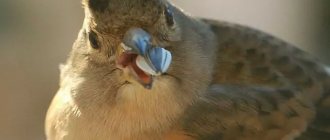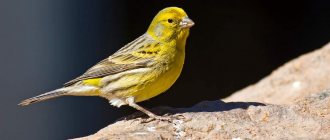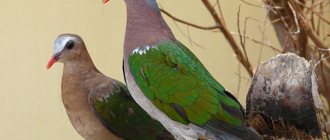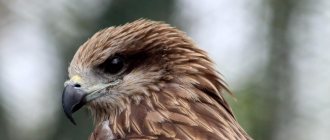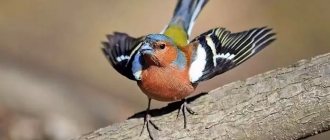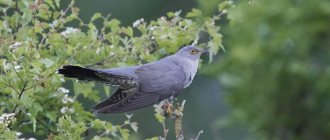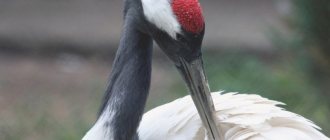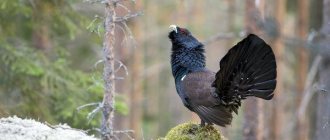Family Finches
Appearance and behavior .
Birds of small and small sizes. The largest representatives are the size of a thrush. The physique is dense, the head is round. The beak is more or less conical, sometimes somewhat swollen or massive. The nostrils are not visible because they are located at the very base of the beak and are covered with feathers. There are 10 primary flight feathers, of which the first is rudimentary, not wider than 1 mm and hidden by hand coverts. There are 12 tail feathers. The legs are medium-sized or small, with curved claws. The plumage is dense and dense. General description . The coloring is varied. Most species exhibit noticeable sexual dimorphism. In some species, noticeable differences in the color of males appear in the second year of life. Complete shedding in late summer or autumn, some partial in spring. In the first autumn, young birds change only their contour plumage.
Lifestyle . Mainly granivores, they also eat soft plant foods. Many species feed their offspring with invertebrates, but there are also many that feed their chicks exclusively with plant foods. They nest in pairs and almost never form colonies. Nests are cup-shaped, on trees, bushes, in rock crevices and shelters under stones. The clutch contains 3–7 eggs, mostly variegated. They nest in a wide variety of conditions - from deserts to highlands, most species are associated with trees and shrubs. During non-breeding times, they often live in flocks or groups. There are few typical migratory species. The majority of migrations are in the nature of migrations of varying lengths. Mountain species usually make vertical migrations. If feeding conditions deteriorate, massive invasions of northern forms to the south occur.
Family composition . An extensive family, distributed almost throughout the world, except for the Australian region and Antarctica. There are more than 120 species. There are 35 species in Russia, 26 in the European part of Russia; 2 of them were accidental.
Source
Description of the Yurok bird
The birds of the finch family have a remarkable appearance. The body size is similar to a sparrow. The color of the plumage depends on the time of year. The plumage on the brisket remains unchanged, which ranges from an orange tint to a terracotta tone.
In cold weather, the back and wings of the bird take on a gray-brown tint. In summer, the plumage changes to black. You can recognize the finch by its wide beak of compact size. The bird's thin, tenacious legs help it to anchor itself on surfaces due to its long claws.
The bird's voice during rest is quiet and melodious. They make a little “pewee-pewie” sound. In flight, it makes a sharper, sonorous “tut-tut.” This is due to their communication signaling system.
Photo of bird finch
Appearance
Representatives of the family are small and medium in size; body length 10-22 cm. Dense build with a short neck, round head and medium-sized wings with dense thick plumage of various colors. Males are usually brighter in color than females; red, yellow and green tones are not uncommon. Wings with nine flight feathers. The tail consists of 12 tail feathers, of medium length (less often short or elongated), straight cut or with a notch in the middle.
The size and shape of the beak vary depending on the food specialization. In some finches, the beak is clearly conical, massive, adapted for peeling or crushing seeds, equipped with a more or less swollen ridge at the base and has no lateral denticles. In other species, the beak is thin and serves to extract seeds from infructescences, for example, burdock; in crossbills, the mandible and mandible intersect at the top - a device for extracting seeds from the cones of spruce (spruce crossbill), pine (pine) and larch (white-winged). The base of the beak does not project at an angle into the plumage of the forehead.
What types of finch are there and their differences?
There are 15 subspecies in the family. Among them the most famous are:
canary finch;
Galapagos or Darwin's finches;
dun finch;
sharp-billed ground finch;
snow finch;
red-capped finch;
The finches of the Galapagos Islands have different beak shapes. The Canary finch differs from its relatives in its lemon plumage, along which gray stripes are distributed. The snow finch is painted in silvery shades. He is one of the few whose plumage color practically does not change with the change of season.
Lifestyle
Many species are associated with woody or shrubby vegetation, living in forests or bush thickets, but there are also desert inhabitants; Some finches settle near human habitation. Northern species are migratory, southern species are sedentary; Mountain finches descend into the valleys in winter.
Most finches live in flocks. The flight of these birds is characterized by an arched line. Finches sing well and have pleasant and sonorous voices.
They feed mainly on plant food (seeds, grains and berries), and to a small extent on insects (mainly during nesting).
Character and lifestyle of the finch
To build nests, finches carefully choose a place away from the tree trunk or deeper in the bushes. This choice is obvious - this way you can protect your future offspring from mammals and large feathered predators.
Some species prefer gregarious life, while others live in separate pairs. However, most often peaceful finches settle in the neighborhood not only with their own kind, but also with other species of birds.
The streamlined body shape and strong wings allow the bird to fly quickly and confidently. During a hunt, the finch can even perform a mind-blowing maneuver to catch an insect that suddenly appears in its field of view in flight. Finches living side by side with humans can gradually get used to it and stop being afraid of people, feeding from feeders.
Having climbed higher - to the top of a tree or the cornice of a tall building, song finches loudly sing beautiful songs. This melody sounds like a combination of trills and whistles, surprising listeners with the variety of sounds.
Listen to the voice of the finch
Nowadays, finches can be found as pets. Of course, an acceptable option for keeping a finch in captivity is only a bird that has lived in such conditions since birth.
Unfortunately, their inquisitive nature and hunger sometimes lead finches into traps, after which they are sold as captive-bred. However, such birds, as a rule, do not feel comfortable in a cage and do not live long.
buy a finch at a specialized pet store; only the presence of all the documents and permits from the breeder can guarantee that the bird was not forcibly torn out of its natural habitat. It is best to get a couple of birds at once, as their flocking nature does not tolerate loneliness.
When deciding to keep such a bird at home, you need to take care in advance about arranging its place of life. The cage should be large, with built-in branches, shelves, and swings.
Birds should always have free access to fresh drinking water. It is worth considering that the characteristics of the body make it mandatory to consume only live food, so you need to stock up on live insects in advance. It is best to equip a separate room for them.
Reproduction
They are monogamous. With rare exceptions, they nest in separate pairs. Nests are made open, from grass and twigs, with a deep tray lined with wool, feathers, hair, etc., on trees, bushes, in undergrowth and on the ground. The nest is built and the eggs are incubated by the female (sometimes a female and a male).
Most species lay eggs once a year, but some lay eggs twice (finches, greenfinches, linnets, etc.) or even three times. One clutch can contain 2-6 (rarely ) eggs, usually variegated. Incubation lasts 10-14 days. The chicks are fed with seeds, regurgitated from the esophagus, sometimes with insects. At the end of the nesting season, they usually gather in flocks.
One clutch can contain 2-6 (rarely ) eggs, usually variegated. Incubation lasts 10-14 days. The chicks are fed with seeds, regurgitated from the esophagus, sometimes with insects. At the end of the nesting season, they usually gather in flocks.
Keeping a finch at home: conditions and feeding
Yurok is one of the few field birds that can be kept at home. However, it is recommended to purchase brambling from nurseries rather than engage in poaching.
REMEMBER! These birds are monogamous. You can catch one representative from a pair, which will cause damage to the family. In addition, the individual may experience stress that will lead to its death.
To keep finches, spacious square or rectangular high cages 80x60x80 cm are sufficient. To prevent the bird from experiencing discomfort, there should be several perches and crossbars inside. The cage should be in a sunny place with fresh air, but not in a draft.
For the nesting site, it is better to make a hanging wooden birdhouse, the entrance of which should be at least 5-6 cm in diameter. If space allows, arrange an imitation of bushes, which finches love so much to build a nest. Line the bottom of the cage with dry herbs, which can be purchased in rabbit and mouse departments. Hay serves as the basis for building a nest.
The bird should always have fresh water and food. Prefabricated mixtures for canaries are suitable for food supplies. On the forums of ornithologists-breeders you can find out the formulas of feed for mixing yourself.
FACTS: Finches live up to 8-10 years.
Yurok on a stump
Classification
The family has 21 genera, one of which (lat. Chaunoproctus
) is extinct:
Depending on the classification, the number of genera may vary, and the family may include up to 29-33 genera, including:
Additionally, finches are often divided into three subfamilies: the finch ( Fringillinae
) (3 species), goldfinches (
Carduelinae
) (122 species) and Galapagos or Darwin's finches (
Geospizinae
) (13 species). [2] Finches are unique to the Palearctic; Goldfinches are very widespread (absent in Madagascar, Australia, Oceania and Antarctica); Darwin's finches inhabit only the Galapagos Islands and Cocos Island.
In earlier classifications, up to 74 genera and more than 500 species of small, mostly forest birds (including even sparrows), distributed in all zoogeographic regions except Australia, were classified as finches. However, later many ornithologists began to separate some genera from finches into independent families, such as, for example, buntings ( Emberizidae
) and passerines (
Passeridae
).
Where do finches live?
The brambling family can be found in all corners of the world, where there is a strip of subcontinental climate. They love the changing seasons with gentle transitions. The feathered bird selects zones and regions with varied terrain.
Main places of settlement:
- Scandinavia;
- Russia;
- inhabit Europe: Oslo, Norway, Estonia, Sweden, Finland;
- Azores;
- South Africa.
The names of subspecies are often associated with their habitat. Thus, Galapagos finches nest on the islands of the same name, leading an almost sedentary lifestyle. At the same time, birds can occupy territories that are not typical for their family.
Photo of the Galapagos finch
An example of this is the vampire finch, which naturalists encountered in South Asia. A few groups may occupy other territories until it is proven how long they remain in those lands.
Photo of a vampire finch
Links
Finches are a family of passerine birds. 133 species, widely distributed. In Russia, usually grosbeaks, goldfinches, siskins, linnets, chaffinches, lentils, crossbills, redpolls, etc. Destroy harmful insects and weed seeds; some damage grains and... ... Big Encyclopedic Dictionary
FINCHES - FINCHES, oh. A family of small birds of the suborder song passerines with a strong thick beak: finches, canaries, crossbills, linnets, bullfinches, tap dancers, siskins, goldfinches and some others. Ozhegov's explanatory dictionary. S.I. Ozhegov, N.Yu. Shvedova. 1949 1992 ... Ozhegov's Explanatory Dictionary
finches - y; pl. A family of passerine birds, which includes the finch, finch, linnet, goldfinch, etc. * * * finches are a family of passerine birds. 137 species, widely distributed. Common in Russia are grosbeaks, goldfinches, siskins, linnets,... ... Encyclopedic Dictionary
Finch - family of birds Neg. passerines. 137 species, widely distributed. Grosbeaks, goldfinches, siskins, linnets, chaffinches, lentils, crossbills, tap dancers, etc. are common in Russia. They destroy harmful insects and weed seeds; some damage grains and... ... Natural history. encyclopedic Dictionary
finches - kikiliniai statusas T sritis zoologija | vardynas atitikmenys: lot. Fringillidae English. finches vok. Edelfinken; Eigentliche Finken; Finken rus. finches; true finches pranc. fringillides; pinsons ryšiai: platesnis terminas – tikrieji… … Paukščių pavadinimų žodynas
Finches - (Fringillidae) family of birds of the passerine order (Passeriformes). Sizes small and medium. Males in many species are brighter colored than females; The color of their plumage often has red and yellow tones. Some V. have a conical, massive beak, ... ... Great Soviet Encyclopedia
Finches - pl. The family of passerine birds, which includes the finch, finch, goldfinch, etc. Ephraim's explanatory dictionary. T. F. Efremova. 2000 ... Modern explanatory dictionary of the Russian language by Efremova
finches - finches, y... Russian spelling dictionary
finches - y; pl. A family of passerine birds, which includes the finch, chaffinch, linnet, goldfinch, etc... Dictionary of many expressions
Source
Finch food
The main food product of finches is various insects. In winter, finches are fed from feeders, eating plant foods. However, if there is no shortage of live food, the finches, of course, will not eat grains. After beetles, caterpillars and spiders are on the list of finches’ favorite delicacies. In addition, birds can eat small nuts and seeds.
Birds of the finch family
Sao Miguel Islands (Azores)
It lives in the Himalayas from central Nepal to Vietnam and in some regions as far south as Thailand.
The birds nest from mid-Alberta to Northern California and migrate south across the Canadian border into the United States and Mexico for the winter.
The white-winged crossbill lives mainly in the Russian taiga, Scandinavia and North America. It prefers to nest in regions with a wide distribution of larches and also feeds on pine seeds.
The habitat is fragmented and consists of three separate sections. The first is located in the Caucasus east of the Elbrus meridian (part of the territory of Georgia, Azerbaijan and Russia). In the Western Caucasus there are rare random couples. The second includes such mountains as Altai, Sayan, Tannu-Ola, Khangai (territory of the Russian republics of Altai and Tyva, Xinjiang Uygur Autonomous Region of China, western Mongolia). In winter, migrated birds can also be found in eastern Kazakhstan. The largest part of the range is made up of the mountainous countries of Central and Central Asia: the Dzungarian Alatau[com 1], Tien Shan, Hissar-Alai, Pamir, Hindu Kush, Karakorum, Himalayas, Tibet, Kunlun, Nanshan. Thus, in the CIS it covers the territories of southwestern Kazakhstan, western Uzbekistan, Kyrgyzstan and Tajikistan; in China - the Xinjiang Uyghur and Tibet Autonomous Regions, Qinghai Province (possibly also Gansu Province), reaching east to the upper reaches of the Yangtze and Mekong, as well as India (Ladakh, Sikkim), Nepal, northern Pakistan (to Gilgit and Chitral) and Afghanistan.
The species is widespread. Its range covers the territory from the south of Bolivia, Chile and Argentina to the Tierra del Fuego archipelago. It also lives on the Falkland Islands. The natural habitat of this species is meadows along rivers, overgrown with bushes.
Inhabits western China, Afghanistan, southern and northwestern Iran, numerous in southern Turkmenistan, in the low parts of Tajikistan, in the deserts of Uzbekistan and southern Kazakhstan (north to the lower reaches of the Syr Darya, Balkhash region, Chui valley, Arys valley).
Found in coniferous forests of the mountains of South Asia, Taiwan and Indoka.
The nesting habitat of the American Evening Grosbeak is coniferous and mixed forests throughout Canada and the western mountainous regions of the United States and Mexico. The bird was extremely rare in the British Isles, with only two known records of such an event.
Breeds in Scandinavian countries and Russia from the Kola Peninsula in the west to the Sea of Okhotsk in the east, in the southern forest-tundra and forest zone, prefers mixed forests. Winters in the south of Western Europe, Turkey, Iran, Turkmenistan, eastern China, Korea, Japan.
Once upon a time, Hawaiian flower girls lived throughout the forests of Hawaii. Now they are found only in mountains at least 900 m above sea level in moist forests or in dry forests at altitudes of about 2000 m.
This bird breeds in Northern Europe and throughout Central Asia. Some mountain tap dancers lead a sedentary lifestyle, but most of them migrate further south or to the sea coasts
subspecies of the Canary finch from the Canary Islands (Serinus canaria). The Canary Canary Finch inhabits the Atlantic archipelagos of the Canary Islands and Azores Islands, as well as the island of Madeira
The common grosbeak lives in mixed and deciduous forests, as well as parks in Europe and Asia, especially where hornbeam grows. The evening grosbeak is a resident of coniferous and mixed forests of North America, including mountainous regions in the west of the continent. The hooded grosbeak, which is closely related to the evening grosbeak, is common in Central America, mainly in Mexico.
from South Africa to Angola
The habitat of this sedentary species occupies temperate forests in the Western Himalayas (in India and Pakistan).
It is represented by three species that are found on the Arabian Peninsula and northern Somalia.
Distributed in Europe, Western Asia and North Africa; settles in the East. One of the most numerous birds in Russia. It lives in forests and parks of all types, often close to human habitation.
Distributed mainly in the western part of the Palearctic region
Source
Lifestyle and habitat
Yurok is very widespread in Russia - from the Baltic states to Kamchatka. Its habitat actually coincides with the forest belt of Russia. The bird has mastered both coniferous and deciduous forests, but whenever possible it still gives preference to deciduous ones, with a predominance of birch.
The brambling's lifestyle is quite typical for a small forest bird. Most of all he loves forest edges with thickets of bushes and plenty of sun. The bird feels confident both in the air (the flight of the brambling is swift, maneuverable, and somewhat arched with alternating short take-offs with frequent flapping wings and short glides) and on the ground (unlike sparrows, the brambling can move not only in leaps, but also fast pace).
In nature, bramblings are found both individually and in flocks. As noted above, such flocks can consist not only of bramblings, but also closely related birds similar to them - for example, finches, and sometimes sparrows or tits.
But, according to reviews from fans of keeping songbirds, in captivity the brambling often becomes uncooperative and can be aggressive towards other birds - especially when kept in a confined space of a cage (for its habit of pulling out the feathers of its neighbors during fights, bird catchers nicknamed the brambling “barber”).
The lively, hot-tempered nature does not allow the nimble to easily put up with cramped conditions and limited mobility. These birds willingly swim or arrange sand baths for themselves.
Is the brambling a wintering bird or a migratory bird ? Rather, it is migratory, but it does not make particularly long flights: with the onset of cold weather, the bramblings gather in large flocks and migrate to the southern border of their range and further - to the south of Europe, Turkey, Central Asia, China and Korea.
On the southern border of the forest zone, some groups of bramblings can stay throughout the winter. Note that what has been said applies specifically to real yurka. Most birds of the finch family do not exhibit migratory behavior.
What are finches?
Small and medium-sized birds. Their body is dense, their beak is conical and relatively massive.
In the fauna of the USSR, the family is represented by 37 species.
The size of a sparrow. The male has a gray-blue top of the head, a chestnut back, a black forehead, and a red-brown underside. The wings and tail are black-brown, the stripes on the sides of the tail and on the shoulders are white. The female is brownish-gray.
The size of a sparrow. The dorsal side is bluish-black, the undertail is white. The throat, crop and chest are light red, the belly is white. The wing has white and orange stripes. The female is duller in color.
Quite easily identified by its characteristic color.
Slightly smaller than a sparrow. The top of the body is brownish-yellow with dark streaks, the ventral side is yellow, the back of the abdomen is white.
There are many similarities with the siskin, but it differs from it in the absence of a black “cap” on its head.
The size of a sparrow. The dorsal side is olive green, the ventral side is yellow-green, the tips of the wings and tail are black. The female is grayish-greenish.
When identifying, you need to pay attention to the canary yellow feathers on the abdomen, wings and tail.
When identifying, you need to pay attention to the black “cap” on the head.
The size of a sparrow. The top of the head, wings and tail are black. The cheeks, forehead, belly, and rump are white. There is a wide red ring around the beak. There is a transverse yellow stripe on the wings.
Identified quite easily by the original color of the plumage. In flight, the yellow stripe on the wings is clearly visible.
It differs from linnet by the presence of a black spot on the throat.
Slightly smaller than a sparrow. There is a small crimson spot on the forehead, the head is gray, the back is brown, the rump is pinkish-gray. There are longitudinal wide black and narrow white stripes on the wings and tail. There are large red spots on the sides of the chest. The underparts are whitish with longitudinal streaks.
Somewhat smaller than a sparrow. The back is pink or white-pink with dark streaks, the ventral side is pink or crimson-pink, the tail and wings are black-brown. There are silvery feathers on the forehead, throat and sides of the head.
Quite easily identified by its long tail and characteristic coloring.
When identifying, it is very important to pay attention to the bright red coloring of the head, crop and chest.
The size of a sparrow. The plumage is crimson pink. The wings and tail are black-brown, with light stripes on the sides of the tail and across the wings. The head and throat are silvery. The abdomen is white.
It differs from Uragus in its larger body and short tail.
Determined mainly by appearance.
The size of a sparrow. The plumage is red. The wings and tail are brown-black. Females are greenish-yellow.
It differs from the shura in smaller size and has a crossed beak.
Identification is mainly based on the characteristic color of the plumage.
Slightly smaller than a starling. The plumage is pinkish-red, the wings, tail and throat patch are black, the middle of the back and shoulders are brown, the neck is gray. The beak is thick and massive.
Identification mainly by characteristic appearance.
Source
Description and features
Most modern city dwellers will hardly be able to identify and distinguish most of the small birds of the Russian fauna - everyone knows only sparrows and tits.
Meanwhile, there are a great many small birds, which in the guides are classified as “the size of a sparrow” or “somewhat smaller than a sparrow,” in Russian forests and fields. One of these quite common, but poorly recognizable birds is the brambling (or finch).
Actually, the name finch is more scientific: the finch belongs to the finch family, which includes many species. Each of these species is called a finch plus some additional definition, for example, “Alpine finch,” “Himalayan finch,” and so on.
Only the most common and familiar bird of the family in Europe and Russia is called the Yurk. Since we will mainly talk about it further, we will also use this name.
The Latin name for the brambling is Fringilla montifringilla, which can be translated as “mountain finch.” This is quite fair: the brambling is indeed the closest relative of the finch, and besides, many representatives of the finch family prefer to live in the mountains.
Despite its low recognition, the brambling is a bird with a rather striking appearance. The back, rump and top of the head of these birds are dark, almost black, the belly and stripes on the tail are white, and the chest and shoulders are colored ocher or orange.
The wings have alternating black and orange-red stripes with white markings. Mature males over the age of 3 years are the brightest colored, especially in the warm season: their orange, black and white tones of plumage are rich and form contrasting spots. Young males and females look duller, the color spots are weakly expressed and smoothly flow into each other.
In winter, adult males also become somewhat duller. Bramblings do not differ in size from sparrows: the bird's length is 14–16 cm, weight is about 25 g. Bramblings have a rather dense build, a rounded body, but the tail is slightly longer than a sparrow's.
Externally, the finch is most similar to the brambling. It is especially easy to confuse these birds due to the fact that they often form mixed flocks in which both species are present. Adult male bramblings are easier to distinguish from chaffinches, since the latter does not have a bright orange color in its plumage. Females and young male bramblings are distinguished by a darker head (without reddish cheeks and a cap with a bluish tint characteristic of finches).
The singing of the brambling is not very euphonious. He does not give long roulades, his voice is rather abrupt and harsh. To convey this in letters, as is often done, is a thankless task. Usually the brambling makes either the usual chirping sound for small birds, or chirps (somewhat similar to grasshoppers, but much more abruptly).

